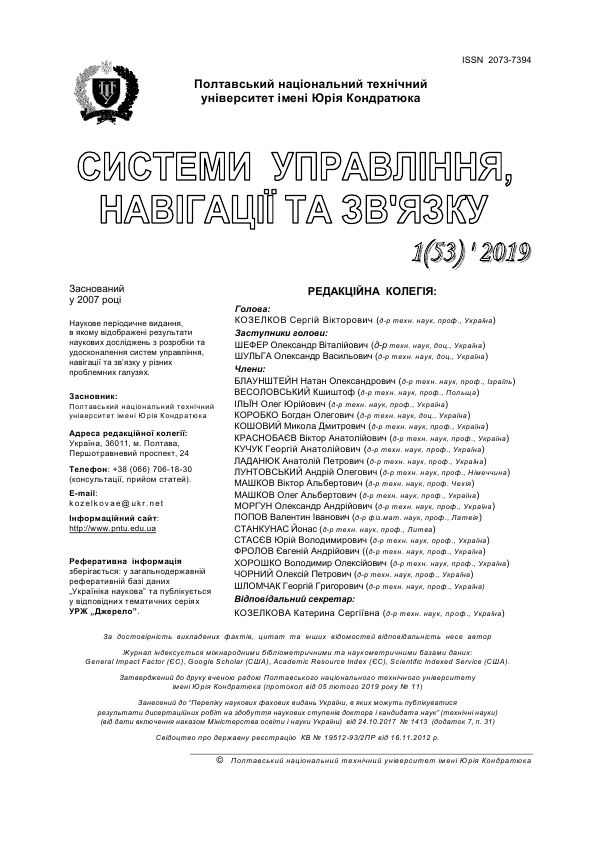METHODS OF THE PREVIOUS EVALUATION OF ELECTROMAGNETIC SITUATION FOR PROJECTING PROTECTING MEANS
DOI:
https://doi.org/10.26906/SUNZ.2019.1.090Keywords:
electromagnetic field, electromagnetic load, shielding, protective properties, noiseAbstract
The sub оf this study is the formation of the electromagnetic environment in the production environment in terms of exposure to it to sources of electromagnetic fields of different amplitude-frequency characteristics. The aim of the work is to develop a methodological approach to the preliminary assessment of the electromagnetic environment in various premises depending on the type and characteristics of the process equipment, electrical network parameters and the introduction of appropriate organizational and technical measures to protect people. The task of the study is to analyze mathematical methods for calculating the levels of electromagnetic fields, depending on the tasks and characteristics of electromagnetic fields. An analytical method to assess the adequacy of mathematical functions for the formation of an electromagnetic environment was used. The paper was shown that computational and experimental methods cannot be used separately. This is due to the mandatory presence of assumptions and simplifications in modeling the propagation of an electromagnetic field around a source and the presence of large amounts of experimental data for their separate use. It is noted that most of the developed tools for assessing the electromagnetic environment relate to a single field source or a group of sources of the same type, which does not meet modern requirements. An applied calculating device for estimating the reduction of a high-frequency electromagnetic field by non-uniform (perforated) shielding surfaces is provided. Based on the ratios of electrodynamics of continuous media, the calculating apparatus is presented to determine the influence on the electromagnetic environment of continuous electromagnetic screens. It is noted that electromagnetic screens, if necessary, can be used to protect against noise and provide numerous data. It was concluded that in addition to the analytical assessment of the electromagnetic environment by traditional methods, it is expedient to develop a software and hardware complex for modeling the propagation of an electromagnetic field from a source. Such software should take into account the geometric characteristics of the premises and the reflective characteristics of the bounding surfaces.Downloads
References
Резинкина М.М. Численное исследование магнитного поля разномерных обьектов / М.М. Резинкина, В.С. Гринченко, Л.Э. Лобжанидзе // Техн. електродинамика. – К., - 2010. –Ч.1. – С. 189-192.
Khalifa T. Electromagnetic Pollution Emitted from Base Station. // International Journal of Science and Research / A. Alnabi // International Journal of Science and Research. – 2015. – Vol. 4. – P. 1125 – 132.
Мордачев В.И. Электромагнитная нагрузка на территорию в неоднородной радиоэлектронной обстановке / В.И. Мордачев // Доклады белорусского государственного университета информатики и радиоэлектроники. – 2012. – № 8(70). – С. 23 – 31.
Мордачев В.И. Необходимый и достаточный уровень мощности электромагнитного излучения базовых станций сети GSM / В.И. Мордачев, А.С. Свистунов // Доклады белорусского государственного университета информатики и радиоэлектроники. – 2013. – № 7. – С. 44 – 50.
Подольцев А.Д. Многомасштабное моделирование в электротехнике / А.Д. Подольцев, И.Н. Кучерявая. – К.: Інститут електродинаміки НАН України, 2011. – 255 с.
Скобликов Ю.А. Результаты моделирования процесса проникновения электрического поля внутрь структурно- неоднородного электромагнитного экрана / Ю.А. Скобликов // Електротехніка і Електромеханіка. – 2011. – №. 4 – С 66 – 71.
Kasar V. A Novel Approach to Electromagnetic Interference Shielding for Cell Phones / V. Kasar, A. Pawar // International Journal of Science and Research. – 2014. – Vol. 3. – P. 1869 – 1872.
Singh J. Computer Generated Energy Effects on Users and Shielding Interference / J. Singh // International Journal of Innovative Research in Computer and Communication Engineering. – 2015. Vol. 3. – P. 10022 – 10027.




